

 |
||
 |
||
Vol. 11 (1): June 2008 |
||
The changing face of marine litterConstantinos Triantafillou
|
|||||||||||||||||||||||||||||||||||||||||||||||||||||||||||||||||||||||||||||||||||||||||||||||||||||||||||||||||||||||||||||||||||||||||||||||||||||||||||||||||||||||||||||||||||||||||||||||||||||||||||||||||||||||||||||||||||||||||||||||||||||||||||||||||||||||||||||||||||||||||||||||||||||
 |
|
|
Samples of marine litter from a beach in the Northern Sporades Marine Park. |
Extensive media coverage over the first months of 2008 have once again brought under the spotlight the resurgent issue of marine litter and plastic pollution (1). Unlike the obvious direct and devastating impacts of a large oil spill in the marine environment, the long-term effects of pollution of our seas and oceans by plastics, which over the years break down into small pellets leaching chemical substances into the environment and entering the food chain, are only just becoming apparent.
Despite efforts so far at the global, regional, national and local level to address the issue, there are indications that the marine litter problem keeps growing. According to the United Nations Environment Programme (UNEP), it is estimated that about 6.4 million tons of marine litter are disposed of in the seas and oceans each year, while 13,000 pieces of plastic litter are floating on every square kilometer of ocean surface! (2).
Plastic garbage items constitute the main threat to the marine environment due to their persistence. Being synthetic materials, plastics are not biodegradable. Through solar heat and photo-degradation they break down into smaller particles that drift for hundreds of years in the marine environment, reaching the remotest parts of the world. Even worse, plastics release the chemical substances they contain, which enter the food chain and constitute a serious threat to the health of marine life and humans alike.
The accumulation of plastics in our seas and oceans has also been highlighted through the work of Charles Moore, oceanographer and founder of the NGO Algalita Marine Research Foundation. Capt. Moore has for over 10 years been studying the build-up of a “plastic soup” in a vast sea area known as the “North Pacific gyre” – a vortex where the ocean circulates slowly because of little wind and extreme high pressure systems. According to his research, it is estimated that close to 100 million tons of plastic are floating only in the North Pacific region, a quantity accounting for 2.5% of all plastics manufactured since 1950.
His last research expedition to the area in September 2007 has been vividly portrayed through a documentary series by VBS TV (3).
The problem of marine litter is also acute in the Mediterranean and is closely linked with the lack of integrated solid waste management systems, coupled with a low level of environmental awareness in the region.
Although there is a lack of data regarding the extent of the problem in the region, the impacts of marine litter are considered serious when taking into account the special characteristics of the Mediterranean Sea (enclosed area, lack of tides, extensive river inflow, endangered marine fauna, high concentrations of coastal populations which double during the summer period) and the importance of the tourism industry to local economies.
A recent assessment study on the status of marine litter in the Mediterranean, which is being implemented by NGOs under the auspices of UNEP’s Mediterranean Action Plan, aims to highlight areas for priority action within the framework of a Regional Strategy to address the problem. Initial findings of this study support those of other studies regarding the changing nature of marine litter.
Within the framework of this assessment study, the Athens-based NGO Hellenic Marine Environment Protection Association (HELMEPA) conducted research on marine litter found on Mediterranean beaches and within the sea itself. Certain findings are of particular relevance to public environmental awareness, and policy, shedding light on the amounts and types of marine litter in the region.
Acting as the national coordinator in Greece of the International Coastal Cleanup (ICC) campaign, a global volunteer initiative of the Washington-based NGO Ocean Conservancy, HELMEPA processed the figures from the Mediterranean countries that participated in the ICC campaign between 2002-2006 (4).
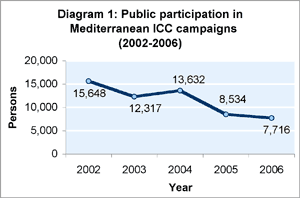 |
|
|
|
Public participation in the ICC campaign in Mediterranean countries decreased steadily during the 2002-2006 period (Diagram 1). Thus, the 15,648 volunteers taking part in ICC 2002 fell to 7,305 volunteers in ICC 2006, which corresponds to a decrease of over 50%.
Although this declining trend can be associated with other factors, such as lack of promotion of the initiative by the organizers or country-specific circumstances (e.g. political turmoil, natural catastrophes etc.), it may also indicate a combination of the following factors:
There is was an overall decrease in the number of items and also the weight of marine litter collected in Mediterranean countries during the 2002-2006 period (Diagrams 2 and 3). In general terms, this follows the decreasing trend in public participation in clean-ups.
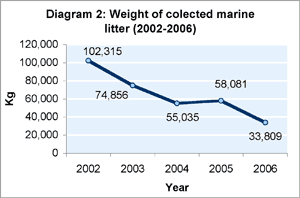 |
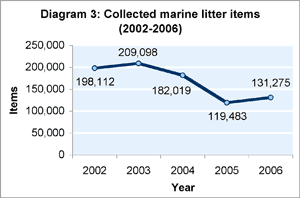 |
|
|
|
|
Due to a number of changing variables every year, i.e. total number of volunteers collecting litter, it is difficult to draw conclusions regarding the overall increase or decrease of marine litter in the Mediterranean during the period under study.
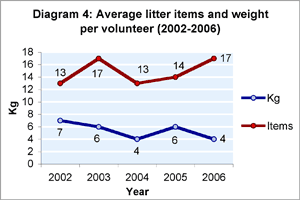 |
|
|
|
However, an interesting observation when examining the average number of litter items and weight per volunteer during the 2002-2006 period (Diagram 4) is that whereas the number of litter items per volunteer increased in the long run, the weight of collected litter per volunteer had a decreasing trend, with the exception of an upward movement between 2004 and 2005. The increase in litter items per volunteer between 2004-2005 was accompanied by an increase of the average weight per volunteer, which may indicate an overall increase in marine litter during that period. However, the following year (2006), while litter items per volunteer increased, the average weight per volunteer decreased once again rather than increased, as one would expect.
This finding indicates that we may be facing a proliferation of lighter marine litter items in the Mediterranean, e.g. plastics, aluminum and smoking-related litter, as opposed to heavier items from dumping activities, such as household appliances, construction materials, car parts, etc.
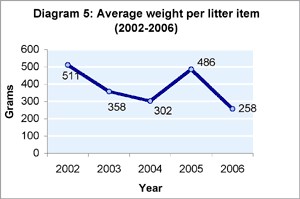 |
|
|
|
Indeed, if we examine the average weight of litter items in the same period (Diagram 5), there is a steadily decreasing trend, with the exception of the 2004-2005 period. Therefore, while the average litter item weighed 511 grams in 2002, it weighed only 258 grams in 2006, which constitutes an almost 50% decrease in weight.
The above finding is further confirmed by an evident decrease in the number of heavy litter items resulting from dumping activities (Diagram 6), which particularly in the case of construction materials was severe. As we can see in Diagram 7, there was also a decreasing trend in the Top 3 plastic marine litter items since 2003. However, these can still be found in large numbers on Mediterranean beaches and in the sea, and considering their highly persistent nature, they constitute a major threat to the Mediterranean marine environment.
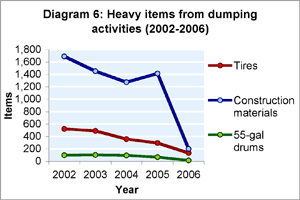 |
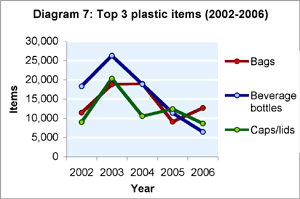 |
|
|
|
|
The decrease in heavier waste items and the predominance of lighter marine litter in the Mediterranean could be due to various factors. It may indicate a gradual increase in the environmental awareness of the general public who, conscious of the impact, do not use beaches as disposal sites for heavy garbage items as casually as they did in the past. Therefore, the removal of these heavier items, combined with the persistent nature of plastics and other lighter marine litter items, which can still be found in considerable numbers in the Mediterranean, has led to the changing nature of marine litter in the region.
Another contributing factor may be the adoption and/or implementation of stricter legislation governing dumping activities, particularly in Mediterranean EU member-states. Or it may be due to a combination of the above and other factors.
Marine litter in the Mediterranean includes a wide variety of items also encountered in other marine and coastal areas of the world. The main types of litter found on Mediterranean beaches, floating on the sea surface or lying on the seabed are listed in Table 1.
|
Table 1 |
|
Plastics: bags, balloons, beverage bottles, caps/lids, food wrappers/containers, six-pack holders, straws/stirrers, sheeting/tarps, tobacco packaging and lighters |
|
Glass: beverage bottles, light bulbs |
|
Paper and cardboard of all types |
|
Metals: aluminum beverage cans, pull tabs, oil drums, aerosol containers, tin cans, scrap, household appliances, car parts |
|
Polystyrene: cups/plates/cutlery, packaging, buoys |
|
Cloth: clothing, furniture, shoes |
|
Rubber: gloves, boots/soles, tires |
|
Fishing related waste: abandoned/lost fishing nets/line and other gear |
|
Munitions: shotgun shells/wadding |
|
Wood: construction timber, crates and pallets, furniture, fragments of all the previous |
|
Cigarette filters and cigar tips |
|
Sanitary or sewage related litter: condoms, diapers, syringes, tampons |
|
Other: rope, toys, strapping bands |
Table 2 presents the Top 12 marine litter items collected from Mediterranean beaches and the seabed during ICC campaigns in the 2002-2006 period, which account for over 89% of total marine litter.
|
Table 2 |
||
|
Item |
Items |
% |
|
Cigarettes/Cigarette filters |
222.563 |
27 |
|
Cigar tips |
86.146 |
10 |
|
Plastic bottles 2 lt or less |
81.238 |
9,8 |
|
Plastic bags |
70.912 |
8,5 |
|
Aluminum beverage cans |
63.282 |
7,6 |
|
Caps/lids |
60.920 |
7,3 |
|
Beverages bottles (glass) |
48.085 |
5,8 |
|
Cups/plates/forks/knives/spoons |
32.037 |
3,8 |
|
Tobacco packaging/wrappers |
23.648 |
2,8 |
|
Food wrappers/containers |
21.029 |
2,5 |
|
Straws/stirrers |
17.184 |
2,1 |
|
Pull tabs |
15.488 |
1,9 |
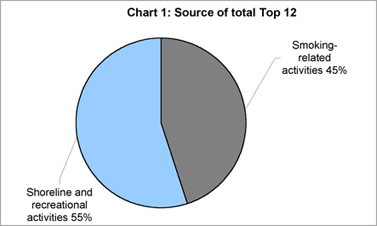
As indicated by the above Chart, 55% of the Top 12 litter items originated from shoreline and recreational activities including mainly plastics (bottles, bags, caps/lids etc.), aluminum (cans, pull tabs) and glass (bottles).
The remaining 45% of the Top 12 marine litter for the 2002-2006 period originated from smokers, including waste items such as cigarette filters and cigar tips, tobacco packaging and wrappers. This percentage for the Mediterranean region was considerably higher that the global average for the same period (32%) and is certainly an area that has to be addressed by policy makers and targeted by awareness raising campaigns.
By far the No. 1 marine litter item in the Mediterranean are cigarette filters (closely followed by cigar tips), which constitute a real scourge for the region and can be found even in the most remote areas. Thus, in the 2002-2006 period, 57,810 volunteers collected 222,563 cigarette filters, which corresponds to almost 4 cigarette filters per volunteer, while the global average in 2006 was only 0.2 cigarette filters per volunteer!
A fact unknown to the majority of the wider public is that it may take between 1-5 years for a cigarette filter to decompose in the marine environment. The slow decomposition of cigarette filters is mainly due to contained substances such as foamed plastic and chemicals, which may also cause serious problems to marine fauna and flora.
Table 3 below provides an indication of the necessary time for the decomposition of various litter items in the marine environment.
|
Table 3 |
|
|
glass bottle |
1 million years |
|
fishing line |
600 years |
|
plastic bottle |
450 years |
|
aluminum can |
80-200 years |
|
rubber boot sole |
50-80 years |
|
plastic cup |
50 years |
|
tin can |
50 years |
|
nylon fabric |
30-40 years |
|
plastic bag |
10-20 years |
|
cigarette filter |
1-5 years |
|
woolen clothes |
1-5 years |
|
plywood |
1-3 years |
|
waxed milk carton |
3 months |
|
apple core |
2 months |
|
newspaper |
6 weeks |
|
orange peel |
2-5 weeks |
|
paper towel |
2-4 weeks |
Source: The Ocean Conservancy, “Pocket Guide to Marine Debris”, 2006.
Sources of marine litter are traditionally classified into land-based or ocean-based, depending on where the litter item enters the water. Other factors such as ocean current patterns, climate and tides, and proximity to urban centers, industrial and recreational areas, shipping lanes, and commercial fishing grounds influence the type and amount of marine litter found in open ocean areas or collected along beaches and ocean including underwater areas (5).
According to GESAMP (6), land-based sources account for up to 80 percent of the world’s marine pollution. Much of the litter reaches the ocean by beach-going activities, being blown into the water, or being carried by creeks, rivers, and storm drains/sewers to ocean areas. Other litter comes from activities on the water, including vessels (from small sailboats to large ships), offshore drilling rigs and platforms, and fishing piers.
As this study was primarily based on the analysis of data collected within the framework of the ICC campaigns in Mediterranean countries, the classification system used is that applied by the Ocean Conservancy.
Chart 2 presents the sources of marine litter in the Mediterranean for the 2002-2006 period.
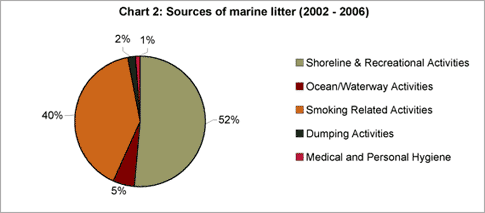
According to the analysis of data collected between 2002-2006, 52% of marine litter in the Mediterranean originated from shoreline and recreational activities. In general terms, this figure is in line with the global average. As we can see in Chart 3, shoreline and recreational activities were the main source every year of the period under study except for 2004, when it was surpassed by smoking-related waste.
Marine litter from smoking related activities accounted for 40% of total marine litter in the same period. Although the number of litter items from smokers dropped significantly between 2004-2005, since 2005 it is on the rise again. The figure for the 2002-2006 period in the Mediterranean is considerably higher than the global average and constitutes a serious problem that has to be given priority in a Regional Strategy to address the issue of marine litter.
Another worrying observation when looking at Chart 3 is that marine litter from shoreline and recreational activities and from smoking-related activities continues to increase between 2002-2003 and 2005-2006 despite the considerable decrease in the numbers of volunteers participating in the ICC campaigns in Mediterranean countries in the same years.
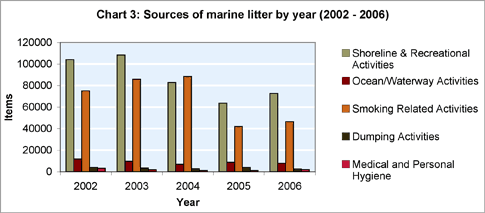
Ocean and waterway activities accounted for 5% of marine litter in the Mediterranean and remained steadily low throughout the period under study. This could be largely due to the fact that all vessels above 400 tons or carrying more than 15 persons are obliged to implement garbage management plans in accordance with international maritime law. Prohibitions regarding the disposal of solid wastes are particularly strict in sea areas with special characteristics, such as the Mediterranean, which is termed a Special Area under the MARPOL International Convention.
Equally low were the figures for marine litter relating to dumping activities and medical/personal hygiene, which are 2% and 1% respectively.
From the above evidence, it is clear that marine litter from shoreline and recreational activities and from smoking related activities are two areas for priority action by regional policies or awareness raising campaigns in the Mediterranean.
The impacts of marine litter on the environment and humans are multi-faceted. Garbage in the sea and on the beaches poses an insidious threat to human health and wildlife: it is estimated that over one million seabirds and 100,000 marine mammals and sea turtles die each year from entanglement in or ingestion of marine litter. Moreover, marine litter degrades the coastal environment and impacts local economies through loss of revenue from tourism as well as damage to boats and fishing nets. These problems are exacerbated by the persistent nature of many of these litter items.
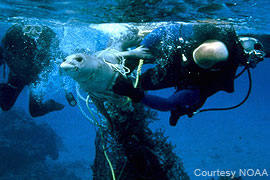 |
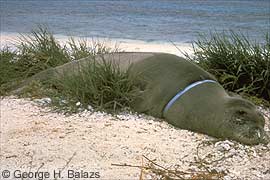 |
|
|
Entanglement in “ghost nets” remains one of the most serious mortality factors and causes of decline affecting the Hawaiian monk seal. Here, a monk seal is being rescued from entanglement in marine debris. |
Hawaiian monk seal entangled by plastic packing strap. |
Although there is a lack of available data on the impact of litter on marine wildlife in the Mediterranean, it is interesting to see the most recent statistics released by the Ocean Conservancy based on the findings of ICC 2007.
In 2007, 378,000 ICC participants in 76 countries worldwide encountered 237 entangled animals. Birds represented nearly 35% of entangled wildlife followed by fish (27%), invertebrates (20%) mammals (almost 13%) reptiles (almost 5%) and amphibians (less than 1%).
Discarded monofilament fishing line is perhaps the single-most dangerous litter item accounting for 65% of entanglements found during ICC 2007. In fact, derelict fishing gear, which includes fishing line, nets, rope, lures and light sticks, and crab/lobster/fish traps, represented 72% of all entanglements.
In the Papahānaumokuākea Marine National Monument in Hawaii, entanglement in so-called “ghost-nets” and other fishing debris remains one of the most serious causes of mortality and species decline affecting the Hawaiian monk seal. Elsewhere in this vast protected area, sea birds perish from ingestion of plastic debris mistaken for food on the ocean.
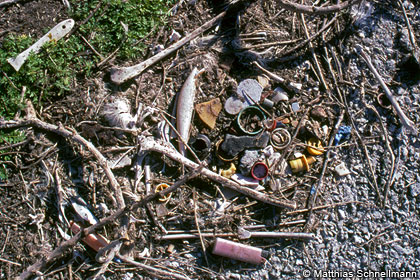 |
|
The remains of a dead Laysan albatross on Midway; amid the bones and feathers, the plastic articles it ingested, but could not expel or excrete, before it died. |
While in the Mediterranean data is not available to differentiate between entanglement in deployed fishing gear as opposed to net debris, incidents of the latter have been recorded in which seals have died as a result of entanglement in discarded nets and net debris.
A detailed account of the ICC 2007 findings regarding entanglements of marine wildlife worldwide are presented in Table 5 below.
|
Table 5 |
||||||||
| Type of litter | Invertebrates | Fishes | Reptiles | Birds | Mammals | Amphibians | Total | Percentage |
| Ballon ribbon/ string | 0 | 0 | 0 | 4 | 1 | 0 | 5 | 2.1% |
| Beverage can | 1 | 1 | 0 | 0 | 0 | 0 | 2 | 0.9% |
| Building materials | 2 | 0 | 0 | 0 | 2 | 0 | 4 | 1.7% |
| Crab/lobster/fish traps | 2 | 1 | 0 | 0 | 0 | 0 | 3 | 1.3% |
| Fishing line | 22 | 32 | 5 | 43 | 8 | 0 | 110 | 46.8% |
| Fishing nets | 13 | 12 | 0 | 6 | 4 | 0 | 35 | 14.9% |
| Glass bottle | 3 | 2 | 1 | 0 | 2 | 0 | 8 | 3.4% |
| Miscellaneous | 2 | 0 | 2 | 5 | 1 | 0 | 10 | 4.3% |
| Plastic bags | 2 | 3 | 0 | 12 | 5 | 0 | 22 | 9.4% |
| Plastic container | 0 | 0 | 0 | 0 | 1 | 0 | 1 | 0.4% |
| Rope | 1 | 9 | 2 | 6 | 5 | 1 | 24 | 10.2% |
| Six-pack holders | 0 | 2 | 0 | 1 | 0 | 0 | 3 | 1.3% |
| Tire | 0 | 1 | 1 | 0 | 0 | 0 | 2 | 0.9% |
| Wire | 1 | 0 | 0 | 4 | 1 | 0 | 6 | 2.6% |
| Totals | 49 | 63 | 11 | 81 | 30 | 1 | 235 | 100% |
| Total percentage | 20.9% | 26.8% | 4.7% | 34.5% | 12.8% | 0.4% | 100% | |
Besides the research study on marine litter collected during beach cleanups in Mediterranean countries, HELMEPA also coordinated a survey of floating litter at sea involving its member-vessels traveling in or transiting the Mediterranean. The survey was based on a simple Data Card, which was used by seafarers for the recording of litter floating on the sea surface.
Between the period February – April 2008, 14 reports were received by HELMEPA member-vessels containing information on litter observations from various sea areas in the Mediterranean, mainly in the eastern Mediterranean (Aegean Sea, Libyan Sea and Eastern Mediterranean Levantine Sea), in the Alboran Sea between Spain and Morocco, and in the Adriatic Sea.
The total number of items of marine litter recorded was 366, corresponding to a concentration of one item per 3 nautical miles (n.m.) or 2.1 items per km2. The concentration of marine litter ranged from 0.08 to 71 items/n.m. Relatively higher concentrations of marine litter were observed along routes close to coastal areas, while there were cases where lengthy observations (more than 120 n. miles) revealed no existence of marine litter.
Plastics accounted for about 83.0% of marine litter items, while all other major categories (textiles, paper, metal and wood) accounted for about 17%, as the following graph shows.
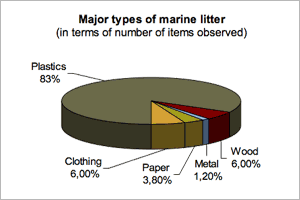 |
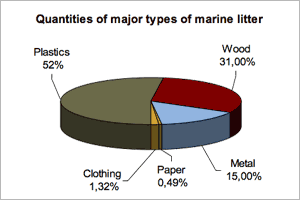 |
|
|
|
|
The average quantity of marine litter was estimated to be 230.8 kg/km2 ranging from 0.002 to 2,627.0 kg/km2. Relatively heavy items such as steel drums, wooden pallets and crates observed on the sea surface were responsible for the greater quantity of marine litter on certain routes. In terms of the length of observation, the average quantity was 0.47 kg/n.m.
One of the initial findings of this assessment study is that we are witnessing a change in the profile of marine litter in the Mediterranean. The steady decrease in the number of heavy litter items on Mediterranean beaches could indicate an increase in the environmental awareness of coastal inhabitants, or the more widespread availability facilities to dispose of them properly. The gradual removal of these heavier items, combined with the persistent nature of plastics and other lighter marine litter items, has led to a significant decrease in the average weight of marine litter items in the period under study.
With regard to types of marine litter in the Mediterranean, by far the No. 1 litter item are cigarette filters and cigar tips. High in the Top 12 list of litter items are also plastics (bottles, bags, caps/lids etc.), aluminum (cans, pull tabs) and glass (bottles). These litter items are highly persistent and do not degrade quickly in the environment, which allows them to continue increasing over time and to travel vast distances with ocean currents and winds, impacting even the remotest parts of the Mediterranean.
The increasing concentration of plastics in the Mediterranean Sea is also verified by the survey conducted in various Mediterranean areas. It should be noted that most types of plastics contain additives in their polymer matrix offering an extended product life, better protection against heat, light or chemicals. Their concentration varies to a great extent, from less than 1% (foaming agents) to 40% (flame retardants, plasticizers and stabilizers), and the slow degradation of plastics at sea might cause leaching of these additives.
One out of two marine litter items in the Mediterranean originates from shoreline and recreational activities, e.g. beachgoers and other users of the coast. This is an area that can be improved significantly by intensifying public awareness campaigns on the insidious nature and impacts of marine litter.
Smoking related waste accounts for 40% of total marine litter in the 2002-2006 study period. This figure for the the Mediterranean is considerably higher than the global average and constitutes a serious problem that has to be given priority in a Regional Strategy to address the issue of marine litter.
Low figures for marine litter from ocean and waterway activities, such as commercial shipping, fishing vessels etc, may be due to the implementation of strict international maritime legislation regarding the disposal of garbage into the sea, particularly in the case of Special Areas such as the Mediterranean. However, special attention should be given to nest, lines and other types of fishing gear, which constitute a major threat to marine wildlife and accounts for 72% of all entanglements worldwide.
The author would like to thank William M. Johnson, Matthias Schnellmann and The Monachus Guardian for sharing their information and photographs for the purposes of this article.
(1) The Independent, 5 February 2008: The world’s rubbish dump.
This Magazine, March-April 2008, Plastic Unfantastic. http://www.thismagazine.ca/issues/2008/03/unfantastic.php
(2) UNEP, 2005: Marine Litter, an analytical overview.
(3) VBS TV, 2008: TOXIC - Garbage Island series 1-12. http://www.vbs.tv/video.php?id=1485308505
(4) Ocean Conservancy, 2002-2006 ICC Annual Reports, Washington D.C.
(5) PERSGA, 2007, Regional Action Plan for Sustainable Management of Marine Litter in the PERSGA Region. Regional Seas, UNEP.
(6) GESAMP (Group of Experts on the Scientific Aspects of Marine Pollution) 1991, The State of the Marine Environment, London: Blakewell Scientific Publications.
Clean Up Greece, HELMEPA and MIO-ECSDE. 2007. Public awareness for the management of marine litter in the Mediterranean: 1-98. [PDF ![]() 10.9 MB]
10.9 MB]
W.M. Johnson, A.A. Karamanlidis, P. Dendrinos, P. Fernández de Larrinoa, M. Gazo, L.M. González, H. Güçlüsoy, R. Pires and M. Schnellmann. 2006. Monk Seal Fact Files. Biology, Behaviour, Status and Conservation of the Mediterranean monk seal, Monachus monachus. The Monachus Guardian, www.monachus-guardian.org.
W. M. Johnson. 2007. Mediterranean: Making A Blue Sea Green, The Monachus Guardian (10) 1: June 2007.
|
An increasing number of companies based around the Mediteerranean are demonstrating new commitment to the environment, including the issue of waste and waste management. One of our sponsors, Piraeus Bank, has recently launched a 3-year initiative to reduce substantially its ecological footprint, in part by improving waste management through cuts in consumption and recycling. Over the duration of the project, the Bank plans to achieve recycling targets of 70% in its disposed paper, 50% of PET plastics and 70% of toners and ink cartridges.
|
Copyright © 2008, Constantinos Triantafillou, The Monachus Guardian. All Rights Reserved |